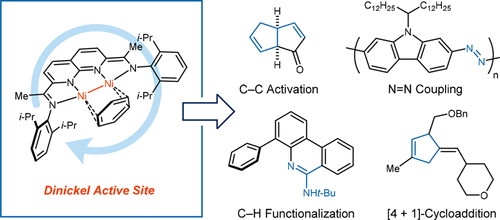当前位置:
X-MOL 学术
›
Acc. Chem. Res.
›
论文详情
Our official English website, www.x-mol.net, welcomes your feedback! (Note: you will need to create a separate account there.)
Dinickel Active Sites Supported by Redox-Active Ligands
Accounts of Chemical Research ( IF 18.3 ) Pub Date : 2021-09-26 , DOI: 10.1021/acs.accounts.1c00424 Christopher Uyeda 1 , Conner M Farley 1
Accounts of Chemical Research ( IF 18.3 ) Pub Date : 2021-09-26 , DOI: 10.1021/acs.accounts.1c00424 Christopher Uyeda 1 , Conner M Farley 1
Affiliation

|
Redox reactions that take place in enzymes and on the surfaces of heterogeneous catalysts often require active sites that contain multiple metals. By contrast, there are very few homogeneous catalysts with multinuclear active sites, and the field of organometallic chemistry continues to be dominated by the study of single metal systems. Multinuclear catalysts have the potential to display unique properties owing to their ability to cooperatively engage substrates. Furthermore, direct metal-to-metal covalent bonding can give rise to new electronic configurations that dramatically impact substrate binding and reactivity. In order to effectively capitalize on these features, it is necessary to consider strategies to avoid the dissociation of fragile metal–metal bonds in the course of a catalytic cycle. This Account describes one approach to accomplishing this goal using binucleating redox-active ligands.
中文翻译:

氧化还原活性配体支持的二镍活性位点
在酶中和多相催化剂表面发生的氧化还原反应通常需要包含多种金属的活性位点。相比之下,具有多核活性位点的均相催化剂非常少,有机金属化学领域继续以单一金属体系的研究为主。多核催化剂具有与底物协同结合的能力,因此有可能显示出独特的特性。此外,直接的金属对金属共价键合可以产生新的电子配置,从而显着影响底物结合和反应性。为了有效地利用这些特性,有必要考虑在催化循环过程中避免脆弱金属-金属键解离的策略。
更新日期:2021-10-06
中文翻译:

氧化还原活性配体支持的二镍活性位点
在酶中和多相催化剂表面发生的氧化还原反应通常需要包含多种金属的活性位点。相比之下,具有多核活性位点的均相催化剂非常少,有机金属化学领域继续以单一金属体系的研究为主。多核催化剂具有与底物协同结合的能力,因此有可能显示出独特的特性。此外,直接的金属对金属共价键合可以产生新的电子配置,从而显着影响底物结合和反应性。为了有效地利用这些特性,有必要考虑在催化循环过程中避免脆弱金属-金属键解离的策略。



























 京公网安备 11010802027423号
京公网安备 11010802027423号